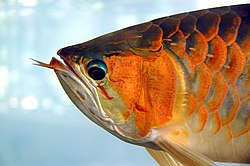Green arowana
| Asian arowana | |
|---|---|
 |
|
| Super red arowana | |
| Scientific classification | |
| Kingdom: | Animalia |
| Phylum: | Chordata |
| Class: | Actinopterygii |
| Order: | Osteoglossiformes |
| Family: | Osteoglossidae |
| Genus: | Scleropages |
| Species: | S. formosus Additional species disputed (see text) |
| Binomial name | |
|
Scleropages formosus (Sa. Müller & Schlegel, 1844) |
|
 |
|
| Synonyms | |
|
|
The Asian arowana (Scleropages formosus) comprises several phenotypic varieties of freshwater fish distributed geographically across Southeast Asia. While most consider the different varieties to belong to a single species, work by Pouyaud et al. (2003) differentiates these varieties into multiple species. They have several other common names, including Asian bonytongue, dragonfish, and a number of names specific to the different color varieties.
Native to Southeast Asia, Asian arowanas inhabit blackwater rivers, slow-moving waters flowing through forested swamps and wetlands. Adults feed on other fish, while juveniles feed on insects.
These popular aquarium fish have special cultural significance in areas influenced by Chinese culture. The name 'dragonfish' stems from their resemblance to the Chinese dragon. This popularity has had both positive and negative effects on their status as endangered species.
Like all members of the Osteoglossidae, Asian arowanas are highly adapted to fresh water and are incapable of surviving in the ocean. Therefore, their spread throughout the islands of southeast Asia suggests they diverged from other osteoglossids before the continental breakup was complete. Genetic studies have confirmed this hypothesis, showing the ancestor of the Asian arowanas diverged from the ancestor of the Australian arowanas, S. jardinii and S. leichardti, about 140 million years ago, during the Early Cretaceous period. This divergence took place in the eastern margin of Gondwanaland, with the ancestors of Asian arowanas carried on the Indian subcontinent or smaller landmasses into Asia. The morphological similarity of all Scleropages species shows little evolutionary change has taken place recently for these ancient fish.
...
Wikipedia

